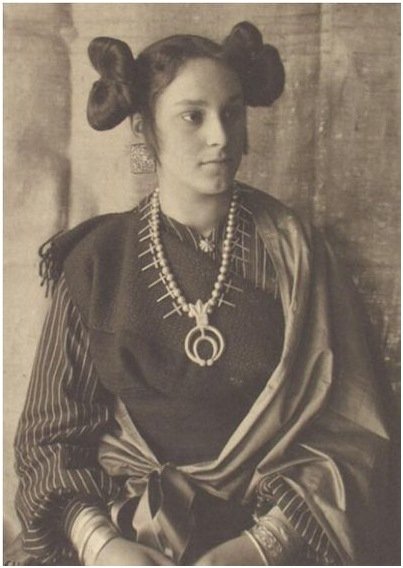Native American Jewelry: A Brief History
1908, Medicine Crow of the Apsaroke Tribe, by Edward S Curtis
Native American jewelry is renowned worldwide for its unique style and distinctive designs. Crafted by indigenous artisans for many thousands of years, the jewelry of the Native Americans is influenced by the land, the spiritual beliefs, the legends, and the cultures of each unique nation, from the American Indians of the Southwest to those in the Northeast. These jewelry pieces have been crafted since the earliest times of the Inca, Aztecs, Maya, and Anasazi.
An Ancient Art Form
Native American jewelry dates back at least as far as 10,000 BC. The Paleo-Indians, who were the first peoples to enter and inhabit the Americas, used shells, stones, antlers, bones, porcupine quills, feathers, and similar materials to create wearable art, and the tribes across the North American continent came to use whatever natural materials were available to them to create adornments. Pendants were ornately carved from fish and animal bones; coral, shells and stones were chipped to create beads to decorate clothing or to make into necklaces. Later on, production of jewelry became more complex and animal teeth, turquoise, copper, semi-precious stones, carved wood, silver, animal claws, pearls, and abalone were used as well.
Function of Jewelry
The wealth of the indigenous peoples of the Americas traditionally had to be portable, and jewelry was not just for decoration and embellishment; it was as much a wearable bank for the owner. It also depicted rank and social class within a tribe.
Traditionally, Native Americans used jewelry to showcase their rank, their history, and their individuality. Jewelry was used to carry traditions between the generations (as written language was never developed by the Native Americans). Jewelry also had an important role in trade between tribes, as styles and designs varied between the different nations.
Technology and creative methods were passed between tribes; for example, the Zuni first incorporated silver into their jewelry designs in the 1870s, after learning the craft of silver-smithing from the Spanish in the 1850s. This knowledge soon travelled to and was adopted by the Hopi, the Navajo, and the Apache, among others.
Hopi Woman
Some Fast Facts:
Beads were incorporated into designs after they were introduced to the Native Americans by the first Europeans to arrive on the North American continent in the 1500s.
Native Americans in the Southwest first began selling jewelry made from silver and turquoise to tourists around 1900.
Stone ear spools (like today’s ear gauges) were worn and also offered at gravesites.
Semi-precious stones were often used, most notably Turquoise but also Charoite, Howlite, and Garnet.
Copper was very popular for use among the Cherokee, as they lived in villages near the copper mines.
Beads were traditionally strung together using plant fibers and animal tendons.
Mother of pearl was used for adornment while clam, conch and oyster shells were ground to make beads.
Beadwork was an important art form used on clothing and regalia which was used to represent the social Small cylindrical beads known as wampum were used by the Indians of the Eastern Woodlands were currency, used to display status, and also to send messages. Midwest tribes were particularly skilled in beadwork, including the Sioux, Chippewa, and Blackfoot. The Iroquois of the Northeast were also renowned for their beading.
The Sioux particularly used animal bones to make jewelry; they also came to be accomplished at metalwork.
The Calusa (southwest coast) were renowned for using shells to make jewelry.
Production of Native American Indian jewelry today is a beautiful way for these unique and talented peoples to honor and continue their traditions and share them in the modern world.



